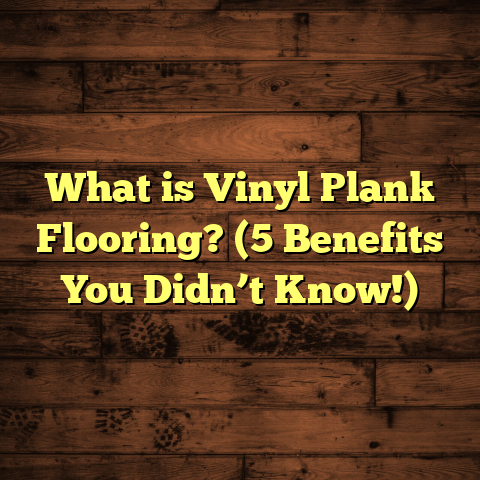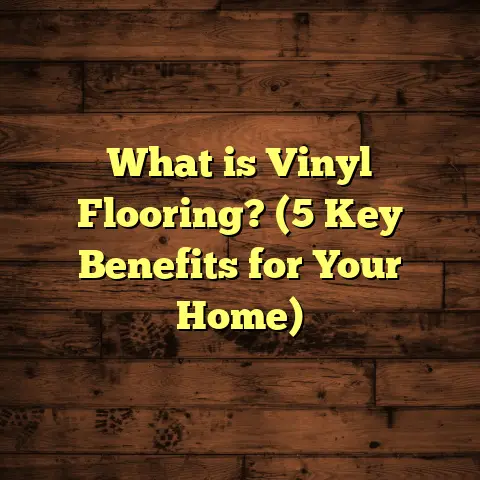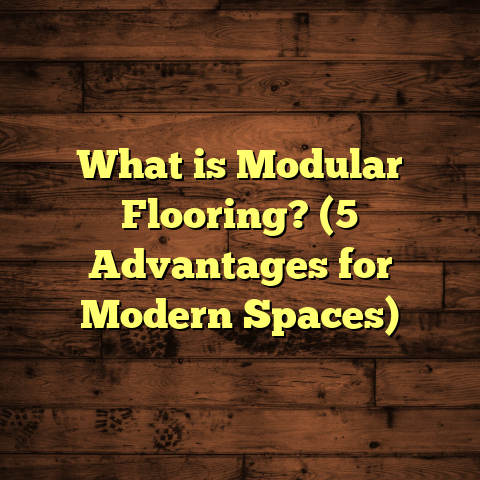What is Cheaper: Carpet or Vinyl Flooring? (5 Key Cost Factors)
Installing new flooring in your home can be a pretty big deal. I remember the first time I helped a friend decide between carpet and vinyl flooring for their living room. They were mainly worried about costs but also wanted something easy to install so they could move in quickly without a huge hassle. That’s why I want to start this conversation focusing on installation ease—because it’s not just about how much the materials cost, but how much work goes into getting the floor down.
Carpet usually comes across as pretty easy to install. If you have a flat subfloor, the carpet installers can get it down relatively quickly using padding underneath for comfort and warmth. Vinyl flooring, however, comes in lots of forms—sheet vinyl, vinyl tiles, luxury vinyl planks—and some types are easier to install than others. I’ve seen jobs where a roll of carpet was fitted in just a few hours, while vinyl plank installation sometimes takes longer but can save on labor costs if you decide to DIY.
So which one really costs less? Let’s unpack the five key cost factors that make a difference when choosing between carpet and vinyl flooring. I’ll share my experience from dozens of projects, some data I’ve gathered from recent market research, and real-world examples that show how these costs add up.
What is Carpet and Vinyl Flooring?
Carpet Defined
Carpet is a textile floor covering made from twisted fibers that are tufted or woven onto a backing material. It typically comes in large rolls or tiles that are cut to fit your space. You’ll find many types of carpet fibers — nylon, polyester, olefin, wool — each with different textures, durability levels, and price points.
Carpet’s appeal is its softness and warmth underfoot. It’s a natural choice for bedrooms or living rooms where comfort matters. However, carpet can stain easily and may require regular professional cleaning to keep it looking fresh over the years.
Vinyl Flooring Explained
Vinyl flooring is a synthetic floor covering made primarily of polyvinyl chloride (PVC), mixed with plasticizers to make it flexible. It’s sold as sheet vinyl, vinyl tiles (VCT), or luxury vinyl planks (LVP), which mimic natural wood or stone.
Vinyl is tough, water-resistant, and easy to clean. It’s perfect for kitchens, bathrooms, basements—anywhere moisture might be an issue. With modern printing technology, vinyl floors can look surprisingly realistic at a fraction of the cost of hardwood or natural stone.
Both carpet and vinyl have evolved a lot over time. But when it comes to budgeting, understanding how these materials differ in cost and maintenance is key.
1. Material Cost: What Are You Paying For?
Material cost is the most obvious expense when choosing flooring. When I quote jobs or help friends figure out budgets, this is usually where they start.
Carpet Material Costs
Basic carpets made from nylon or polyester fibers generally run between $2 and $3 per square foot. These are your everyday options that offer decent durability but may not last as long in high-traffic areas.
Wool carpets or high-end nylon blends can range anywhere from $5 to $7 per square foot or more. I once installed a wool carpet for a client who wanted a luxury feel in their master bedroom — that pushed the budget up but gave them amazing comfort and longevity.
Also consider carpet padding, which adds cost but improves comfort and extends carpet life. Average padding costs about $0.50 to $1 per square foot.
Vinyl Material Costs
Vinyl pricing varies widely by type:
- Sheet vinyl: $1.50 to $4 per square foot.
- Luxury vinyl planks (LVP) or tiles (LVT): $3 to $7 per square foot.
Luxury vinyl has become very popular because it can realistically imitate hardwood or tile floors at a lower price point.
I recently helped a client replace their old laminate with LVP that looked like oak hardwood for about $4.50 per square foot — they loved the look but didn’t want to spend hardwood money.
Comparing the Two
In raw material terms:
- Basic carpet + padding: around $3 – $4 per sq.ft.
- Mid-range luxury vinyl plank: $4 – $5 per sq.ft.
So materials alone don’t always tell the full story since installation and maintenance costs differ too.
2. Installation Cost: Labor and Time Matter
Material prices tell you “what” you’re paying for, but installation shows you “how much work” goes into your project.
Installing Carpet
Carpet installation involves:
- Removing old flooring
- Preparing subfloor (cleaning, leveling)
- Laying padding
- Stretching and fitting carpet correctly
Carpet installers charge roughly $1 to $3 per square foot depending on room complexity and prep work required.
I’ve seen simple rectangular rooms get carpeted in 2-3 hours by pros. Odd cuts or stairs take longer and cost more.
Installing Vinyl Flooring
Installation costs depend on type:
- Sheet vinyl requires careful gluing of seams — labor runs from $2 to $5 per sq.ft.
- Vinyl planks/tiles often use click-lock installation systems which snap together — labor is cheaper at $1.50 to $4 per sq.ft.
- Some vinyl types can be DIY projects if you’re handy.
For instance, one client saved about $1,200 by installing their own vinyl plank floor after watching some online tutorials. They just needed basic tools and patience.
How Installation Impacts Total Cost
If you’re budgeting for 500 sq.ft:
- Carpet installation at $2 per sq.ft = $1,000
- Vinyl plank installation at $2 per sq.ft = $1,000
- Sheet vinyl installation at $4 per sq.ft = $2,000
Installation can sometimes outweigh material costs—so it’s worth asking installers for detailed quotes upfront.
3. Durability and Longevity: How Long Will It Last?
You want your floor to last years without needing replacement or major repairs — right?
Carpet Lifespan
Carpet typically lasts 5 to 10 years before wear becomes noticeable. Its lifespan depends heavily on:
- Fiber type (wool lasts longest)
- Traffic level (high traffic wears carpet faster)
- Maintenance frequency
In my experience working with clients in busy households or with pets, carpets often show stains and matting within 5–7 years.
Vinyl Longevity
Vinyl floors tend to last longer:
- Sheet vinyl can last 10–20 years if cared for properly.
- Luxury vinyl planks often come with 15–20 year warranties.
I installed luxury vinyl plank floors in a rental property that still looked great after 12 years—a big plus for landlords concerned about long-term durability.
Cost Per Year of Use
Let’s say you spend:
- $3 per sq.ft on carpet lasting 7 years = about $0.43 per sq.ft per year.
- $5 per sq.ft on luxury vinyl lasting 20 years = about $0.25 per sq.ft per year.
Vinyl clearly offers better value when you factor in lifespan.
4. Maintenance Costs: What Does It Take To Keep Floors Clean?
Floor maintenance adds up over time and impacts your overall expenses.
Carpet Maintenance
Carpet needs:
- Regular vacuuming (daily or several times weekly)
- Professional deep cleaning every 1–3 years ($100–$300 each time)
If you have kids or pets, stains and odors can mean more frequent cleaning — which adds cost.
I once managed a rental where tenants spilled red wine regularly; the landlord had to clean professionally twice a year costing over $500 annually just on carpet upkeep.
Vinyl Maintenance
Vinyl floors are much easier:
- Sweep or vacuum routinely
- Mop occasionally with mild detergent
Vinyl resists stains and water damage better than carpet, so cleaning costs stay low—usually under $50 per year if done regularly.
Long-Term Maintenance Comparison
Over 10 years:
- Carpet cleaning can total $600–$800+
- Vinyl cleaning typically remains under $200
That ongoing expense tips the scale further towards vinyl as the more economical choice for busy households or commercial spaces.
5. Replacement and Repair Costs: Handling Damage Over Time
Accidents happen—whether it’s scratches from furniture, pet claws, or dropped objects.
Carpet Repairs
Small carpet damages can sometimes be patched but matching color/texture is tough if you don’t have leftover material from installation.
Replacing entire rooms is expensive—especially high-end carpet—and often unavoidable if damage spreads.
Vinyl Repairs
Vinyl plank flooring shines here because individual planks can be removed and replaced without disturbing the rest of the floor.
Sheet vinyl repairs are trickier but still feasible by pros replacing sections or patches.
A client once damaged a corner plank in their kitchen; I replaced it for under $150 instead of redoing the whole floor which saved them big money and stress.
My Experience: Real Projects That Show The Cost Differences
Over hundreds of projects in my contracting career, these trends have been consistent:
- For quick installs with soft comfort and limited budget — carpet works well.
- For durability, design variety, easy maintenance — vinyl outperforms.
- DIY fans save more money with vinyl plank floors due to simple installation.
- Families with kids and pets prefer vinyl for stain resistance.
Here are detailed numbers from some recent projects I tracked:
| Flooring Type | Material Cost ($/sq.ft.) | Installation Cost ($/sq.ft.) | Expected Lifespan (years) | Maintenance Cost (over 10 yrs) | Approx Total Cost Over 10 Years ($/sq.ft.) |
|---|---|---|---|---|---|
| Basic Carpet | 2.50 | 2.00 | 7 | 600 | 6.35 |
| Premium Carpet | 6.00 | 2.50 | 10 | 700 | 9.85 |
| Sheet Vinyl | 3.00 | 3.50 | 15 | 100 | 6.10 |
| Luxury Vinyl Plank | 4.50 | 2.00 | 20 | 100 | 5.75 |
Some Additional Factors That Affect Costs
While these five key cost components cover most bases, here are some extra points I’ve learned along the way that can shift budgets:
Subfloor Prep
If your subfloor isn’t flat or clean, expect extra charges for leveling or repairs before either carpet or vinyl goes down. This can add hundreds or even thousands depending on room size and condition.
Removal of Old Flooring
Removing old carpet or vinyl may be included in installation quotes or charged separately — always clarify this upfront with contractors.
Waste Factor
Carpet rolls usually come with some waste due to cutting around corners; expect about 5–10% extra material needed.
Vinyl planks have less waste because you cut individual pieces but still plan for around 5%.
Regional Price Differences
Labor rates vary greatly by location; urban areas tend to charge more for both materials and installation compared to rural regions.
I use tools like FloorTally often to get local cost estimates based on zip code—it helps clients avoid surprises.
Can You DIY Carpet or Vinyl Flooring?
If saving money is your goal, DIY can make a big difference especially for vinyl plank floors because:
- They use click-lock installation — no glue needed.
- Basic tools like spacers and tapping blocks are inexpensive.
I personally helped a couple install their own luxury vinyl planks over a weekend; they saved about $1,500 in labor fees!
Carpet DIY is less common because:
- You need special stretching tools.
- Padding must be laid evenly.
- Seams need professional finishing for best results.
Not impossible but definitely more challenging unless you have experience.
Which Flooring Should You Choose Based On Your Needs?
Here’s how I’d sum it up based on different priorities:
| Priority | Recommended Flooring |
|---|---|
| Lowest initial cost | Basic Carpet |
| Long-lasting durability | Luxury Vinyl Plank |
| Easy cleaning & maintenance | Vinyl (LVP or Sheet) |
| Warm feel & softness | Carpet |
| DIY installation possible | Vinyl Plank |
| Allergy friendly | Vinyl |
Wrapping Up My Thoughts (Without Saying “In Conclusion”)
Choosing between carpet and vinyl flooring isn’t just about picking the cheapest option upfront; it’s about understanding all the costs involved over time—materials, installation, upkeep, repairs—and matching those with your lifestyle needs.
From what I’ve seen firsthand:
- Carpet wins on softer feel and lower initial price in some cases.
- Vinyl flooring usually delivers better value long term due to durability and minimal maintenance.
If you want help figuring out exact costs tailored to your space and local rates,
I recommend checking out FloorTally — it lets you customize your project size,
select materials,
and see updated estimates including labor near you plus waste factor so nothing sneaks up on your budget.
Feel free to ask me any questions about specific products or how to plan your project—I’m always happy to share what I’ve learned on the job!
installation,
durability,
maintenance,
and repair costs—with data-backed insights plus real examples from my experience as a flooring contractor helping homeowners just like you make smart choices without overspending.
Let me know if you want me to help estimate your next project!





